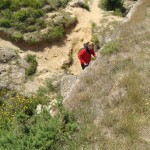Visiting a battle site feels a bit like trespassing. The rich sands of Pointe Du Hoc stretched out beyond my feet, pockmarked by trenches and spots carved out for large weaponry, radiating with an invisible richness, like each blade of grass among the specks of sand was a story pushing itself out of the earth and asking to be told. The water beat back along the shore, in rhythm with the breeze, cold despite the bright sun. A looming gray rock cliff stands tall in the water, remniscient of the Allied soldiers who once marched proudly across the beach as they invaded Normandy. History surrounds a visitor to a battlefield, yet most stories will lay dormant, scattered in the waves and waving in the breeze, never to be relived.
This is Pointe Du Hoc as I remember it.
Muir likens exploring a natural space in real life to reading a book. If only it were that easy in the digital world. My first virtual trip to Pointe Du Hoc, France, one of the sites of military action during the Normandy Beach invasion on D-Day, was largely a geometric blur, largely unlike what I remembered of it from when I visited a summer or two ago. My second trip was worse, because Earth was somehow stuck in ground level view, a useless tool for a place with no buildings, and the entire beach was just a flat yellow space with the cliff sharply standing out in the background. I tried to travel around a bit, but the space was incredibly blurred and half-loaded. The photos that others have uploaded to Earth, however, help create a disjointed picture of the place.
Digital exploration, for me, has rarely provided the same experience as actual travel in a place. The sights, the sounds, the smells, the feeling of the wind and the total realization of what role you actually play in your environment has never translated to me through a computer screen, where I feel detached from the surroundings. Yes, you can gather the beauty, or the potential for beauty through the screen, but similar to my argument against e-books, there’s nothing like being there and experiencing it firsthand.Also, the lagginess and the loading, however brief, usually add to the disjointed feeling of the digital exploration.
I think even a textual tour can sometimes be more powerful than a digital tour because it conveys the feeling of a place using every sense, and not just one-dimensionally through sight. There are emotions, there are stories, there are connections between the reader and the place that may not be conveyed otherwise. I am not a person who can just stand and look and feel something – I’m really bad at art museums for that reason – I need to be active and involved, and I think that’s why for me digital worlds are not ideal – they don’t give me much to do besides click around and stare.
There’s certainly no harm to exploring a digital world. For those places we may never get to visit in reality, Google Earth and even Second Life are good, if not interesting tools for exploring the area, getting a feel for what it looks like, what being there might be like. But in my eyes, a digital tour does not provide the same experience as visiting or even reading about a place.
(I’ve included some pictures from when I visited to illustrate what the place actually looks like as compared with the GE version)






Kelsey: You address some of the limitations of exploring a space through Google Earth fairly well, but I don’t see an effort to look beyond just Google Earth. There are a number of different digital tools you could pursue to really see if the digital can compete with text in creating a sense of space and place for the reader/interactor.
I couldn’t find the location in Second Life and I thought we were supposed to use one of those two tools, I didn’t realize we were supposed to look at other tools. I’d be happy to do that and do additional analysis in my post if you’d like.